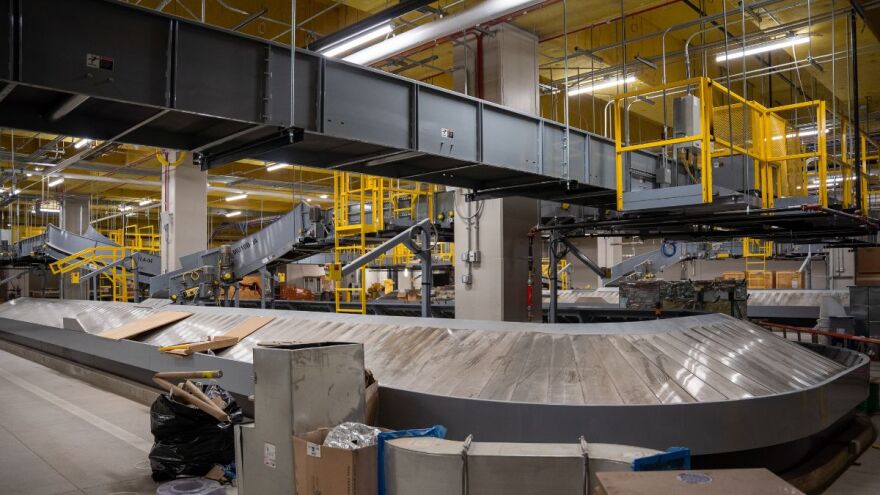The opening date for Kansas City’s new airport terminal is Feb. 28, and the public will get the chance to see the city’s costliest infrastructure project at an open house on Feb. 18.
Serious conversation about a new terminal began a little less than a decade ago, and the road to the terminal’s opening has been turbulent. Even now, controversies swirl around the process by which the developer was selected.
But after the city selected Edgemoor Infrastructure and Real Estate to design and finance the terminal, Kansas City voters overwhelmingly approved the project. Nearly six years and $1.5 billion later, the new terminal is set to open in just more than a month.
It promises accessibility improvements, locally owned concessions and plenty of public art.
But the new terminal is a massive — and expensive — undertaking. And according to the measure that voters approved in 2017, it explicitly cannot receive city funding beyond airport revenue. So where does $1.5 billion to pay for the terminal come from? And why is it $500 million more expensive than initially anticipated?
Here’s a breakdown of the terminal’s finances.
Projected budget vs. the final price tag
The cost estimate for the terminal has varied greatly since the project was approved in 2017. Initially, the estimate sat around $964 million, and it fluctuated around from $1.3 billion to $1.6 billion before settling on its current budget of $1.5 billion.
Why the changes? In short, the terminal got bigger.
Pat Klein, director of the Kansas City Aviation Department, said that during the initial airport evaluation in 2016, called “Exhibit K,” the city recommended a $964 million airport terminal that would contain 35 gates.
Once voters approved the project in November 2017, the city reentered negotiations with airlines to finalize the project’s budget.
“In 2017, we started doing some of the design stuff, and the airlines said, ‘Here’s what we plan on flying in Kansas City,’” Klein said. “And when we looked at the numbers, they actually wanted to build a 39-gate facility.”
This increased the budget to $1.68 billion, he said, which the city and the airlines negotiated down to a maximum budget of $1.5 billion.
The larger size of the terminal will also allow the facility to be expanded in the future. There’s enough space for an additional three gates, two baggage claim devices and two security lanes, if an increase in airport traffic makes another upgrade necessary.
KCI will finish paying for the airport in 2058

So far, 90% of the airport has been paid for — the Aviation Department has already paid $1.35 billion, with $148 million left in the budget.
The money came from bonds — the department borrowed $1.5 billion in 2019 and 2020, with a blended interest rate of 3.88%. This means the department will make payments of $95 million a year for 35 years.
“That annual debt payment is paid through a combination of airport revenue,” Klein said. “So the airline rents, the parking revenue, the concessions, all of that totals, let’s say $75 million. For each passenger that goes through the airport, we get $4.50. That equals about $20 million annually. So that’s how we pay the debt back.”
The COVID-19 pandemic taught the airline industry a hard lesson in 2020 — that airport traffic is not a guarantee, making airport revenue potentially unstable.
With that in mind, the Aviation Department cut a deal with the airlines to make sure the city’s rainy day fund is untouched: If the airport’s revenue is insufficient to pay for the yearly $95 million debt repayment, the airlines serving KCI are obligated to step in and help pay.
“If there were another March 2020, where revenue would dry out for four or five months, the airlines would be on the hook to cover, to make sure that we made that $95 million debt payment in that year,” Klein said. “They’ve taken on that responsibility to be the backstop to make sure that we’re good.”
All airlines serving KCI sign this agreement, which means that as long as flights are coming to the Kansas City airport, the city will meet its debt repayments.
The cheapest upgrades and the most expensive costs

Out of the $1.5 billion budget, one of the biggest expenses was the new baggage claim system, which includes miles of baggage conveyors. This cost somewhere around $50 million.
Concrete was also expensive, making up around $70 million of expenses.
Klein is particularly excited about the new glass boarding bridges, which will take the place of the beige tunnels that are often used in American airports. He said it was a cheap upgrade from the steel option, totaling around $34 million for 39 bridges, plus one extra.
“If you’ve been to Europe and traveled at all, they’ve got glass boarding bridges all over Europe,” he said. “It brings the customer experience all the way out to the cockpit. It’s a much better experience if you’ve got 50 people waiting to board that plane, and you’re standing in that glass boarding bridge, you can see what’s going on outside.”
Klein said that with 39 bridges, the new KCI terminal will be the largest airport in the U.S. that uses glass boarding bridges.
This story was originally published on the Kansas City Beacon, a fellow member of the KC Media Collective.




